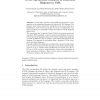Free Online Productivity Tools
i2Speak
i2Symbol
i2OCR
iTex2Img
iWeb2Print
iWeb2Shot
i2Type
iPdf2Split
iPdf2Merge
i2Bopomofo
i2Arabic
i2Style
i2Image
i2PDF
iLatex2Rtf
Sci2ools
UML
2000
Springer
2000
Springer
Dynamic Meta Modeling: A Graphical Approach to the Operational Semantics of Behavioral Diagrams in UML
In this paper, dynamic meta modeling is proposed as a new approach to the operational semantics of behavioral UML diagrams. The dynamic meta model extends the well-known static meta model by a specification of the system's dynamics by means of collaboration diagrams. In this way, it is possible to define the behavior of UML diagrams within UML. The conceptual idea is inherited from Plotkin's structured operational semantics (SOS) paradigm, a style of semantics specification for concurrent programming languages and process calculi: Collaboration diagrams are used as deduction rules to specify a goal-oriented interpreter for the language. The approach is exemplified using a fragment of UML statechart and object diagrams. Formally, collaboration diagrams are interpreted as graph transformation rules. In this way, dynamic UML semantics can be both mathematically rigorous so as to enable formal specifications and proofs and, due to the use of UML notation, understandable without p...
Collaboration Diagrams | Natural Language Processing | Operational Semantics | UML 2000 | UML Diagrams |
| Added | 25 Aug 2010 |
| Updated | 25 Aug 2010 |
| Type | Conference |
| Year | 2000 |
| Where | UML |
| Authors | Gregor Engels, Jan Hendrik Hausmann, Reiko Heckel, Stefan Sauer |
Comments (0)

